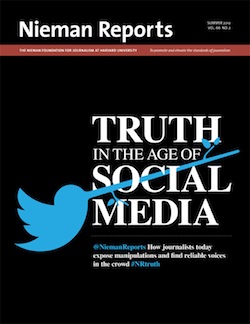Editor’s Note: Our colleagues upstairs at Nieman Reports are out with their Summer 2012 issue, “Truth in the Age of Social Media,” which focuses on issues like verification, crowdsourcing, and citizen journalism. Over the next few days, we’ll give you a glimpse at some of their stories — but make sure to read the issue in full. In this piece, Storyful’s Mark Little describes what it takes to separate fact from fabrication in an online world.
 When I was a young TV journalist, the phrase “golden hour” meant the early evening light that bathed faces and landscapes in a warm forgiving glow. As a social journalist, I’ve started to use the term in a different way.
When I was a young TV journalist, the phrase “golden hour” meant the early evening light that bathed faces and landscapes in a warm forgiving glow. As a social journalist, I’ve started to use the term in a different way.
I now think of the golden hour as the time it takes social media to create either an empowering truth or an unstoppable lie, when a celebrity death trends on Twitter or an explosive video surfaces on YouTube. In other words, when journalism can matter most.
When I founded Storyful in 2010, I imagined a news agency built for the social media age. I wanted to create the products and protocols that would equip other journalists to meet the challenges of the golden hour.
At Storyful, we think a combination of automation and human skill provides the broadest solution. We are a news agency but also a technology start-up. Our engineers work side by side with our journalists.
The Storyful development team is building products that will help our journalists and clients map influence and connections within social media conversations and get an early warning of changes in their speed or intensity.
We are also working to scale the techniques our editorial team has perfected in validating videos and images. At its core, this process is built around a checklist.